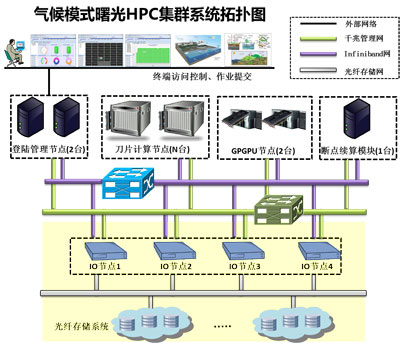
Welcome to Login
微信登錄
打開(kāi)手機(jī)微信,,掃描二維碼

掃描成功
請(qǐng)勿刷新本頁(yè)面,按手機(jī)提示操作

中科曙光不會(huì)以任何理由要求您轉(zhuǎn)賬匯款,,謹(jǐn)防詐騙

您的微信還未注冊(cè)

中科曙光不會(huì)以任何理由要求您轉(zhuǎn)賬匯款,謹(jǐn)防詐騙
您可以同時(shí)關(guān)注中科曙光微信公眾號(hào)
使用微信掃一掃即可登錄,! 查閱資料更方便,、 快捷!
您已經(jīng)注冊(cè)賬號(hào)和
關(guān)注微信公眾號(hào)

2025年1月
服務(wù)熱線:400-810-0466

Met-ocean and Environment
From day-to-day weather forecasting to large-scale climate research, from land to sea, from surface hydrometeorology to space weather, Twilight's high-performance computers are active. Sugon's “send” super-calculation system for the National Meteorological Administration represents the super-calculation system. Beginning to lead China's own meteorological research work, while Sugon provides technology, products and solutions for the promotion of "smart weather".
1.Climatic model system
General Circulation Model (GCM) is the mathematical model describing planetary atmosphere or ocean. It is based on Navier-Stokes equations of rotating sphere, including thermodynamics to reflect a lot of energy sources (such as radiation and latent heat). These equations are the basis for complex computer program to simulate the earth's atmosphere or ocean. Atmospheric and oceanic general circulation models (AGCM and OGCM), sea ice and land surface process are crucial parts of Global Climate Model. AGCM and Global Climate Model are widely applied in areas such as weather forecast, understanding climate and predicting changes of climate, as well as in researching climatic model of time scale from ten years to one hundred years, the numerical models of which need massive calculation and integrate all kinds of equations in fluid mechanics, chemistry, and sometimes biology. At present, major climatic model system are CCSM and CESM.
1.1 CCSM3
As one of the widely used complex climatic numerical simulation systems at present, CCSM3 was originally established in 1996, developed and provided technical supports by American National Center for Atmospheric Research (NCAR). In June 2004, NCAR launched CCSM3, which recently participated in the related research on the fourth assessment report of the professional committee of the Intergovernmental Panel on Climate Change (IPCC), extensively applied in research on areas such as analyzing the influence of human activities on the global climate change and the ancient climate change process.
CCSM3 is the data exchange between major modules of atmosphere (ATM), ocean (OCN), sea ice (ICE), land (LND) and coupler (CPL). It adopts hybrid parallel computing model, the whole system of which uses distributed parallel method to achieve independent operation of each sub-module and data exchange between modules, while each sub-module adopts MPI parallel mode between different computing nodes. Now CCSM3 is used for research and operation on areas such as ocean and climate in many research institutes, and the model is of good extensibility.
1.2 CESM
CESM is a new-generation Earth System Model launched by American NCAR in July 2010, and a fully coupled climatic model. In CESM1.0, models such as atmosphere, land, ocean, sea ice and land ice are included. It is mainly used to research climatic situations of the earth’s past, now and future. The full name is Community Earth System Model, the Chinese name of which is “Gong Yong Di Qiu Xi Tong Mo Shi”.
The predecessor of CESM is CCSM, which is a climate system model, coupling models such as atmosphere, land, and ocean and sea ice. Among which, CCSM1.0 was launched in July 1996, with recent update in April 2010, having launched CCSM4.0. Development from CCSM to CESM is a trend.
In the area of climatic model, implementation personnel are required to possess good debugging and integration ability on the system, which mostly demands good extensibility, and high requirements on storage and network’s performance. Parts of modules in CESM also support GPU calculation.
2. Solutions
As to requests of climatic model field’s application in areas such as computing performance, computing scalability, network and storage performance, Sugon Company brought out a set of complete cluster solutions. The overall topography of the scheme is shown as follows:

Hardware scheme is mainly composed of three parts of computing system, network system and storage system, among which computing system adopts mixed architecture of x86 computing blade plus GPGPU computing node, not only exerting the advantages of high-performance cluster computing and good parallel scalability of the blade, but also taking advantage of large-scale and ultra parallel computing of the latest GPGPU, so as to fully satisfy the needs of large calculated amount in climatic model. To configure fault-tolerant module of Sugon Clusnap cluster and support breakpoint calculation of models such as CCSM and CESM effectively solves the problem that the climatic model needs to start over calculation after the calculation was suspended due to failures of software and hardware during simulation of a long time span. Network system employs “double-network” approach of Infiniband computing network and Ethernet control network; both networks are relatively independent and able to realize redundancy, to ensure the high reliability of cluster network. The cluster is configured with the light storage disk array of SAN schema, combining multiple IO nodes as a parallel file system, which achieves the balance between storage capacity and read-write performance.
Dawning Information Industry Co.,Ltd. Sugon Building, No.36 Zhongguancun Software Park, No.8 Dongbeiwang West Road, Haidian District, Beijing 100193
Tel:+86 400-810-0466
Fax:+86 10-56308222
E-mail:[email protected]
Dawning Information Industry Co.,Ltd. Sugon Building, No.36 Zhongguancun Software Park, No.8 Dongbeiwang West Road, Haidian District, Beijing 100193
Tel:+86 400-810-0466
Fax:+86 10-56308222
E-mail:[email protected]



 Register /
Register /